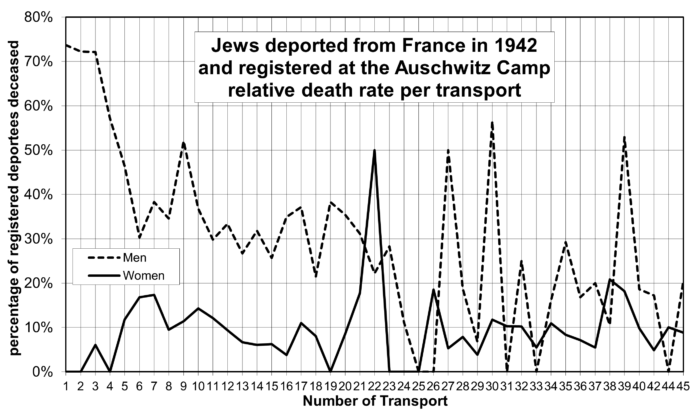France
France’s role in the Holocaust was twofold. First, during the German occupation of northern France, the French government in southern France collaborated with the German authorities and agreed to have those Jews living in France deported to Auschwitz who either had no French citizenship or who had obtained it only recently. The deportation lists have been preserved and were published in 1978 by Serge Klarsfeld. They contain 75,720 names.
The second aspect of France’s role unfolded after the war, when French prosecutors and investigators sought to bolster the case of Allied prosecutors that horrendous crimes against humanity had been perpetrated by German forces and officials during the war. This aspect of France’s contribution to postwar propaganda is discussed in detail in the section on France of the entry on propaganda. Hence, the following will focus on the fate of the Jews deported from France.
The French police recorded the names, birth dates and birth places of all Jews deported toward Auschwitz. At Auschwitz, those Jews who were registered in the camp were recorded with the same data – at least theoretically. Practically, some variations in the way names and towns are spelled do occur, but for the most part, these differences still allow an identification. If a person registered in the camp died, the Auschwitz camp authorities registered that death in a number of documents, most prominent among them in the Death Books (Sterbebücher; see the entry on the Auschwitz Death Books). Forty-six volumes of these Death Books have survived the war, covering all of 1942 and most of 1943.
A person-by-person comparison of the deportation lists with all entries in the Death Books and some other extant documents on deceased Auschwitz inmates reveals the fate of those deportees who were admitted into the camp.
Altogether 45 transports with Jews from France were deported to Auschwitz in 1942, almost all of which contained roughly 1,000 deportees. All deportees transported with the first six trains leaving for Auschwitz between March and mid-July 1942 were admitted and properly registered in the camp. Then things started changing due to the typhus epidemic raging at Auschwitz, which led to a complete lockdown of the camp on 23 July 1942. Of the next seven trains arriving in late July 1942, the majority of inmates was still admitted to the camp, but a few were not. All later transports of 1942 had only a minority of usually a few hundred inmates or less registered at the camp.
Initially, the orthodoxy claimed that the inmates deported but not registered were killed on arrival in the “gas chambers.” However, later research has revealed that an unknown number of deportees was taken off the train prior to its arrival at Auschwitz. The German authorities evidently decided to admit them to various labor camps in the larger region of Upper Silesia rather than exposing them to the unsafe conditions prevailing inside the Auschwitz Camp. Other inmates may have stayed at Auschwitz only briefly, to be deported further east to other camps or ghettos. The documentation on this is very incomplete (see Rudolf 2019b).
The orthodoxy claims that those deemed unfit for labor were killed on arrival at Auschwitz. However, up to mid-July, everyone was registered, even the very old and very young. From transports arriving later, many if not most adults in the prime of their working years (20 to 50 years of age) were not registered at Auschwitz – precisely because the stepped off the train elsewhere.
The data also shows that the mortality of the French Jews deported during the first four transports was shockingly high: between 50 and 70% of them died within the first two years of having been admitted to Auschwitz. The survival rate of deportees admitted later, on the other hand, was considerably better, although still catastrophic by any decent standard. (See the chart.) Women in general fared much better than men.
The highest death rate among the deportees from France occurred in August 1942 with 1,782 casualties. This coincides with the peak of mortality for the entire camp of 8,507 deceased inmates during that month, mainly due to the raging typhus epidemic. The available, incomplete documentation shows that almost half of all Jewish men deported from France and admitted to the camp died there, and some 10% of all admitted women. Since many later volumes of the Death Books are missing, the total number is most likely higher, although the mortality in general subsided considerably in late 1943 and in 1944 – only to escalate again toward the end of the war due to the generally catastrophic circumstances in collapsing Germany.
The orthodoxy considers only those Jews deported from France as survivors who returned to France after the war and registered there as a survivor. Precisely 2,566 of the originally deported 75,720 Jews did exactly that. However, most Jews deported from France were not French citizens but rather refugees from central and eastern Europe, and those who had French citizenship had obtained it only recently. Therefore, it stands to reason that many of them, displaced as they were, decided to emigrate elsewhere instead (Israel, USA etc.). But even if they returned to France, many may have distrusted French authorities and decided not to register with them. It is impossible to estimate how many might have made such a decision.
Either way, the Jews deported from France did indeed experience a shoah – catastrophe – at Auschwitz. However, this catastrophe did not occur in homicidal gas chambers, but rather due to the catastrophic hygienic and sanitary conditions.
(For more details, see Aynat 2023; Mattogno 2022b, pp. 101-105, 109, 116-118, 129.)


You need to be a registered user, logged into your account, and your comment must comply with our Acceptable Use Policy, for your comment to get published. (Click here to log in or register.)